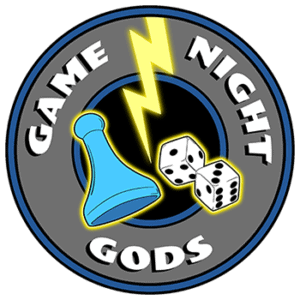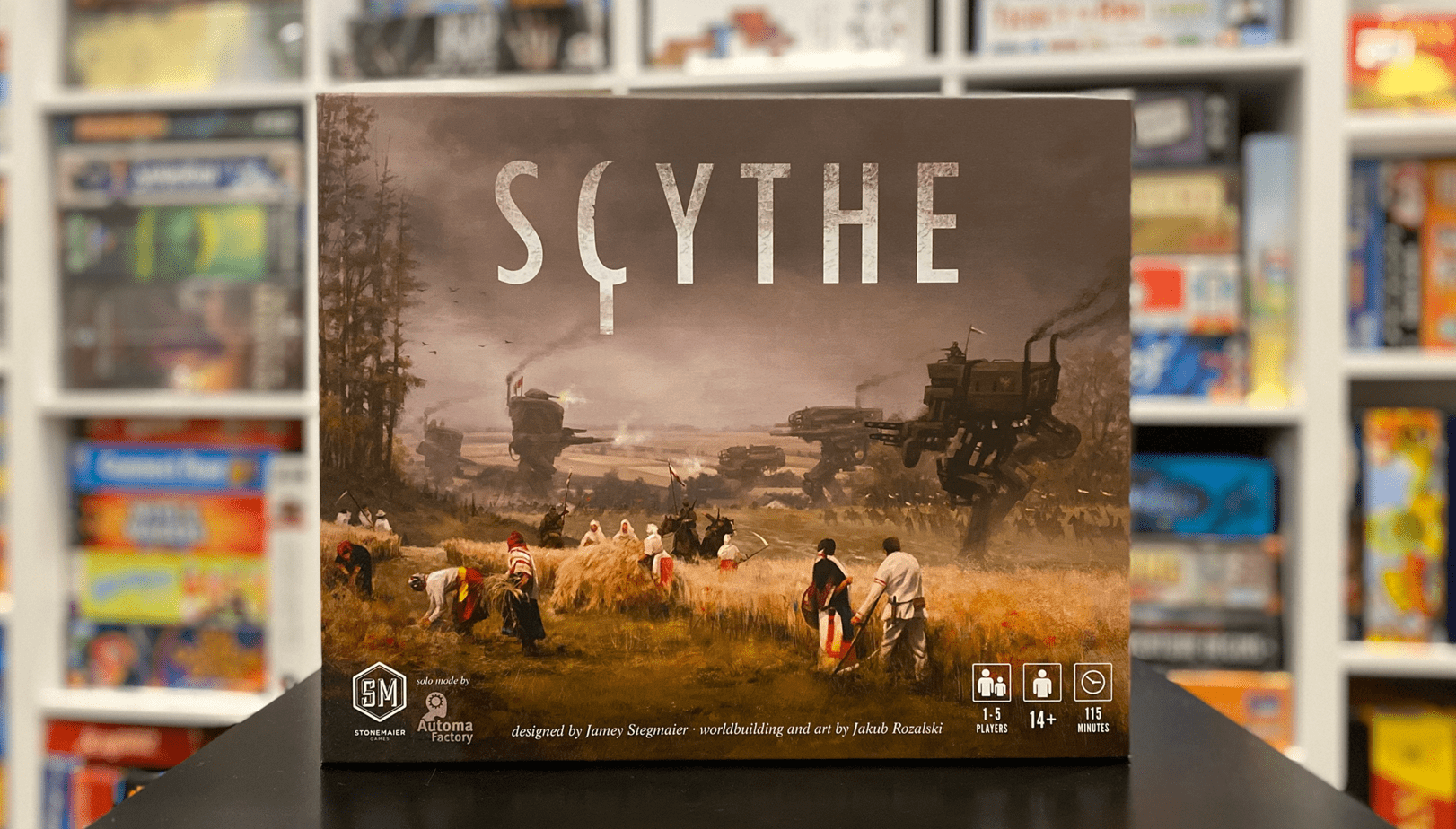In the board game Scythe, each player represents a character from one of five factions of Eastern Europe in an alternate history of the 1920s. This intense strategy game is considered one of the best board games out there, with beautiful artwork and a deep storyline, but does it play just as well? We will go over all of the details in this Scythe Board Game Review.
The board game Scythe raised over $1.8 million on Kickstarter, showing the sheer hype and excitement for this board game to be produced and released into the hands of eager board gamers.
What is Scythe?
Scythe is a board game from Stonemaier Games that was released in 2016 and can be played with 1-5 players. It quickly became a unique and challenging board game that captured the essence of 1920s Eastern European culture.
With territories to control and heavily armored mechs roaming the lands, your goal is to lead your faction to victory by becoming the richest in the land.
The setting is intriguing, and the mechanics are both simple and complex. The game is perfect for those who enjoy strategy games with a bit of a learning curve. We highly recommend Scythe for anyone looking for an immersive and engaging board game experience.
But don’t just take our word for it, read on to find out more about this engine-building board game and whether it deserves a place on your board game shelf. We will dive deep into the gameplay, game experience, strategies, and our thoughts on the pros and cons of the game.
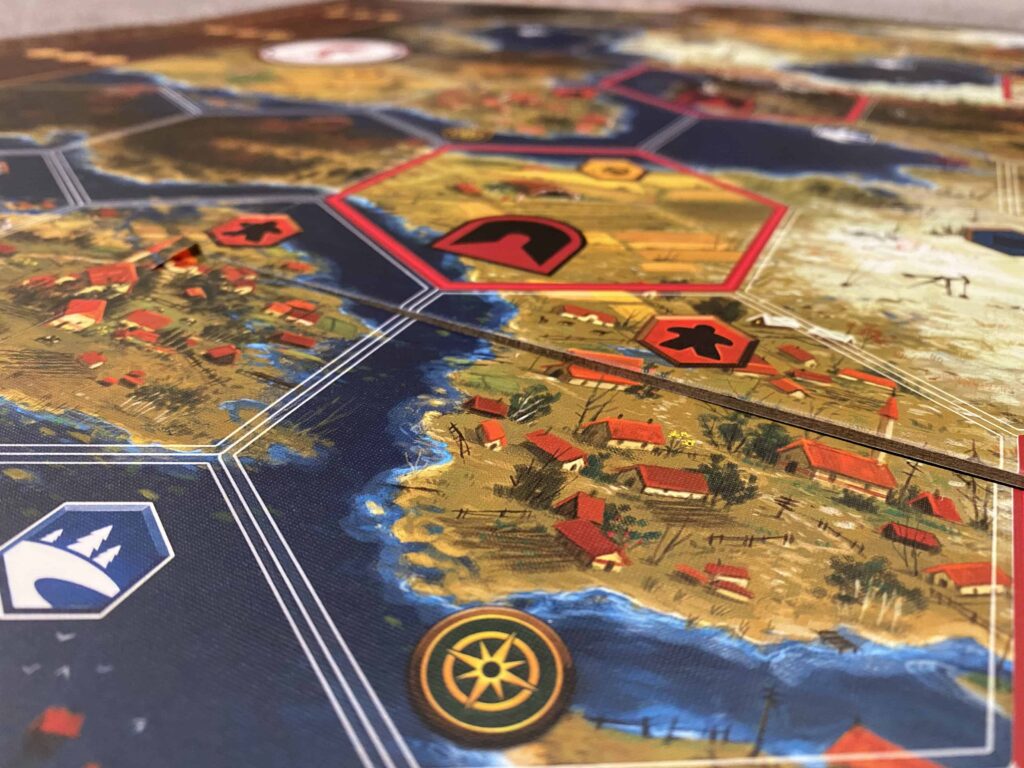
Scythe Gameplay
The Scythe game board is based on an alternate version of Europe where countries have been renamed and borders have been changed.
Each player represents a character from one of five factions of Eastern Europe. Players must work within their factions to expand their empire and infiltrate as many territories as possible. As players conquer territory, they will be able to gather different resources and build their empires.
The game board consists of terrain hexes that each produce a different resource. Each faction will have a character figure, as well as 8 total workers. The main character will start at a designated home base, while 2 of the 8 workers will start on adjacent hexes.
During gameplay, each player begins by choosing one of four action areas to activate. Each action area has a top and bottom row, each will have different actions to perform.
The top-row actions include moving (up to 2 units you control), bolstering (gain power or combat cards, trading (trade for resources or popularity), and producing (producing resources in areas you control)
The bottom-row actions include upgrading (improving top row efficiency, while also reducing the cost of the bottom row actions), deploying (add mechs to the board where workers are present), building (add a structure to a territory you control), and enlisting (enlist new recruits and earn bonuses)
As you deploy and unlock mechs onto the game board, they each have special abilities based on your faction. This increases more opportunities to move around the board, as one mech can cross rivers, while another can carry workers from one space to another.
There is also a combat feature that erupts if a player has moved one of their heavily armored mechs into a territory that is occupied by another player. Players will then have to secretly choose a number on their power dial (not more than their power level) and reveal their chosen number. Combat cards can help increase this number as well. Whoever has the highest number wins the battle. If the player attacking wins, they now control the territory and all of the resources.
Throughout the game, players will continue to take the different top and bottom actions and expand their territories. As they conquer new territories, they will harvest different resources, enhance their abilities, build structures, and work to increase their coin base and popularity.
On top of all of this, there are also different objectives and achievements to earn throughout the game. These will help earn more points/coins that will help in your end game.
The goal of the game is to have the most fortune by the end of the game. Fortune is granted by how much you harvested and how much money you made from your harvest. Unlike other games, the winner is not determined by how many battles you have won. The game ends when one faction has placed their 6th and final star on an achievement section of the board. After adding up points, territory, and popularity, the player with the most points wins.
Key Components and Mechanics of Scythe
Scythe is a strategic board game with mechanics weighing heavily on engine building aspects, action selection, area control, and resource management. With Scythe being an engine-building game, players can upgrade actions to become more efficient, build structures for better positioning on the map, enlist new recruits, use mechs to deter enemies, and expand their borders to increase their gains on resources. This will all be done on the board and player mat in front of you.
The game board is modular, which means that it changes with each game. It features a unique action selection mechanic in which players can choose to either take an action or pass. This mechanic requires players to make tough decisions and allows for a lot of strategic planning.
Players must also manage their resources carefully, as running out of resources can lead to defeat.
One of the biggest things that stands out in this board game is the outstanding artwork and the production value of the components. The quality components consisted of both wood and plastic pieces. The artwork on the cover of the box immediately grabbed my attention and find out what lies inside the box.
The board game set includes high-quality cardboard pieces, including faction mats and miniatures with stands, initiative trackers, resource tokens, battle dice, and more. There is also a rulebook, for multiplayer and solo players, which provides an overview of the game mechanics as well as scenario rules.
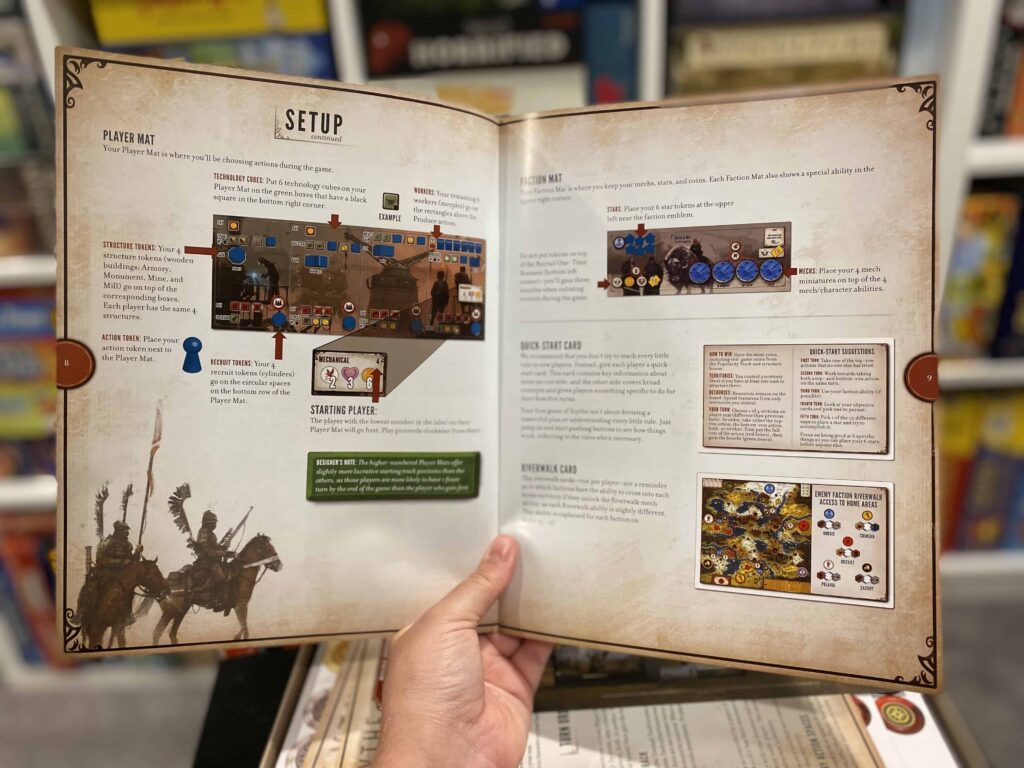
Here is the full list of components:
- 2 rulebooks (multiplayer and solo)
- 1 quick reference guide
- 5 player mats
- 5 faction mats
- 1 game board (624x818mm); the back can be combined with a separate board extension for bigger hexes
- 80 wooden resource tokens
- 80 coins tokens
- 12 multiplier tokens
- 12 encounter tokens
- 6 structure bonus tiles
- 42 combat cards
- 23 objective cards
- 28 encounter cards
- 12 factory cards
- 2 power dials
- 5 riverwalk cards
- 5 quick-start cards
- 5 wooden action tokens
- 5 wooden popularity tokens
- 5 wooden power tokens
- 36 wooden star tokens
- 20 wooden structure tokens
- 20 wooden recruit tokens
- 20 plastic mech miniatures
- 5 plastic character miniatures
- 48 wooden workers
- 36 wooden technology cubes
The game can be played with 1-5 players and takes approximately 2 hours to play.
The Factions & Characters in Scythe
The factions and characters in Scythe are varied and interesting. The five factions are Nordic Kingdom, Rusviet Union, Polania Republic, Saxony Empire, and Crimean Khanate.
Each faction has its own strengths and weaknesses, which leads to different strategies for each faction. See each faction and their unique special ability:
Nordic Kingdom
Faction special ability: Workers can swim across rivers
Mech special abilities: Riverwalk (walk onto forest and mountains), Seaworthy (character and mechs can move onto lakes), Artillery (before combat, players can pay 1 power in order for their opponent to lose 2 power), Speed (they have a speed of +1)
Rusviet Union
Faction special ability: Choose the same section back to back on their action mat (same as the previous turn)
Mech special abilities: Riverwalk (walk onto farms and villages), Township (Move between any village you control), People’s Army: In combat, you can play one more combat card with at least one of your workers, Speed (they have a speed of +1)
Crimean Khanate
Faction special ability: Use one combat card per turn as a resource
Mech special abilities: Riverwalk (walk onto farms and tundra), Wayfare: Mechs and characters can move from territory back to your home base, Scout: players can steal one combat card from their opponent before combat, Speed (they have a speed of +1)
Polania Republic
Faction special ability: Choose two options on encounter cards
Mech special abilities: Riverwalk (walk onto villages and mountains), Submerge: Mechs and characters can move onto lakes and from one lake to another, Camaraderie: players will not lose popularity when enemies retreat during combat, Speed (they have a speed of +1)
Saxony Empire
Faction special ability: Stars received from combat are not limited
Mech special abilities: Riverwalk: (walk onto forests and mountains), Underpass: Mechs and characters can move from and to mountains and tunnels (only adjacently), Disarm: opponent will lose 2 power if combat takes place on a tunnel or mine. Speed (they have a speed of +1)
The characters in Scythe are also well-developed and have their own backstory. Each player in Scythe controls a character from one of the five factions seeking control of territories and unclaimed lands.
These characters include:
- Anna & Wojtek (Polania Republic [white/red])
- Gunter von Duisburg with Nacht & Tag (Saxony Empire [black/gold])
- Zehra & Kar (Crimean Khanate [yellow/green])
- Bjorn & Mox (Nordic Kingdom [blue/white])
- Olga Romanova & Changa (Rusviet Union [red/gray])
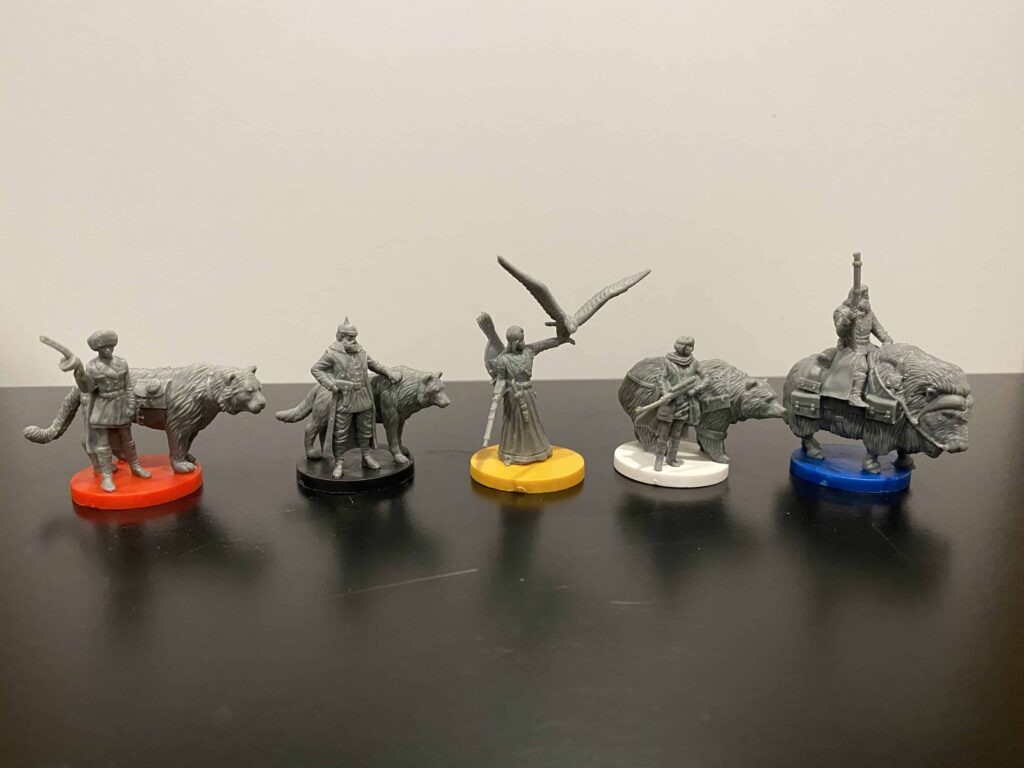
Read more about each character and their backstories here.
Our Experience Playing Scythe
The board game Scythe can seem very daunting at first, but at the end of the day, we had a lot of fun playing Scythe. The action selection mechanic kept the game exciting, and the modular game board provided a lot of replayability. The game was challenging but not too difficult, and we felt like we had a lot of control over our fate.
The artwork is phenomenal and something we made sure to take in as we were playing the game. The blend of resource gathering, exploration, and combat is pretty much perfect in my opinion. There is not too much of one thing, and the game had a very nice balance.
The strategy involved in Scythe is deep but not overwhelming, and we liked that the game rewarded careful planning. We would definitely recommend Scythe to anyone looking for a complex and rewarding board game experience.
Here is what we liked most about Scythe:
Not too much combat
As you know, many great war games revolve heavily around combat. Seeing Scythe for the first time, we thought that this would be a combat-heavy game. To our surprise, we found that there was pretty light combat involved, and the game focused rather on developing your player board and building resources. The idea of building up your faction and conquering territories was enough to bring excitement. Scythe can still be considered a great war game, but it just involves so much more.
The strategy involved
We love strategy board games and working to gain complete control over a game board. The strategy of managing our player board and building our engine is what helped us thrive in the game, not luck.
Theme and artwork
We love a good theme when it comes to board games, and even better if the board game has fantastic artwork. This Stonemaier game achieved both and it was well worth the money we paid just on the artwork and theme alone.
Click here to purchase your own copy of Scythe
Pros and Cons of Scythe
With a great game can always come things where it falls short. So here is our list of pros and cons for the Scythe board game.
Pros:
- The game is challenging but not too difficult and offers a lot of strategic depth.
- The artwork is phenomenal and helps to create a unique and engaging gaming experience.
- The action selection mechanic keeps the game exciting and prevents it from becoming stagnant.
- The game board is modular, providing a lot of replayability.
Cons:
- The game can be very daunting at first and may take multiple playthroughs to fully understand.
- The game is not suitable for younger players due to the level of strategic depth required.
- The game can take a long time to play, up to 2 hours.
- If you like games with high combat, then this probably isn’t for you
Scythe is a great game for anyone who enjoys complex board games. The modular game board provides a lot of replayability, and the unique action selection mechanic is both interesting and challenging. The game can be time-consuming, and there is a bit of a learning curve, but overall we found Scythe to be a rewarding and enjoyable experience.
Scythe Board Game Strategies
Now that you know a bit more about Scythe, let’s take a look at some strategies for playing the game. Here are a few tips:
1. Manage your resources carefully. Resources are key to success in Scythe, and running out can be disastrous.
2. Use the action selection mechanic to your advantage. This mechanic allows you to choose when to take action and when to pass, so use it wisely.
3. Plan your moves carefully. The game rewards careful planning, so take your time and think things through before making your move.
4. Take advantage of your faction’s strengths. Each faction has its own strengths and weaknesses, so play to yours.
5. Keep an eye on the victory conditions. There are multiple ways to win in Scythe, so know what they are and adjust your strategy accordingly.
Scythe Board Game Review Final Thoughts
If you’re looking for a complex and rewarding board game experience, Scythe is worth checking out. The game has a high learning curve, but it’s well worth the effort. The strategy involved is deep but not overwhelming, and the game rewards careful planning.
You can either stick with the base game or expand your gaming experience with one of the 3 expansions of Scythe.
Click here to purchase your own copy of Scythe
If you’re looking for something to keep you entertained for hours on end, Scythe is a great option. Thanks for reading!
